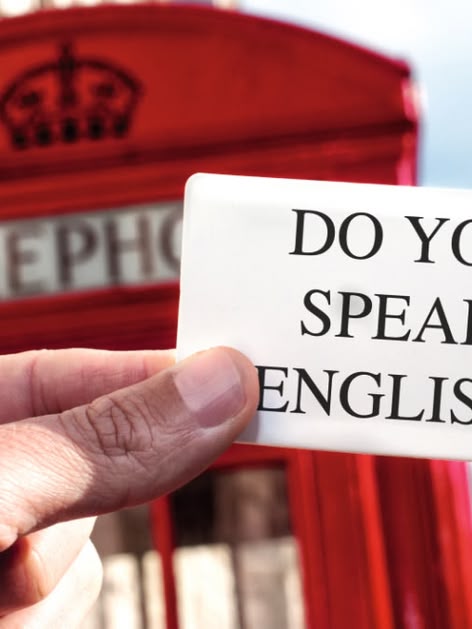Learn to Count in English: Numbers Up to 100 Explained
How to Learn English Numbers Effectively

Counting in English may be complicated at first, but once you understand the pattern, you will quickly be able to use the listening English numbers as well. Counting to 100 in English is the first and most important step to mastering English numbers quickly.
First, you should learn English counting to 20. These English numbers are irregular and form the basis. Therefore, you should learn them by heart. After that, you need to understand the pattern and only learn the tens to 90.
The English numbers 13 to 19 end in -teen (thirteen, which means "thirteen"), while the tens end in -ty (twenty, which means "twenty"). Also remember that the hyphen is used between tens and units, for example for 21, 22, 23, 24 ("twenty-one", "twenty-two", "twenty-three", "twenty-four") and so on. After 100, "and" is also used, especially between the number 100 and the tens. An example? The number 120 becomes "one hundred and twenty". However, the "and" is often not pronounced in spoken English.
Counting from 0 to 20 in English
| Number | Written |
| 1 | One |
| 2 | Two |
| 3 | Three |
| 4 | Four |
| 5 | Five |
| 6 | Six |
| 7 | Seven |
| 8 | Eight |
| 9 | Nine |
| 10 | Ten |
| 11 | Eleven |
| 12 | Twelve |
| 13 | Thirteen |
| 14 | Fourteen |
| 15 | Fifteen |
| 16 | Sixteen |
| 17 | Seventeen |
| 18 | Eighteen |
| 19 | Nineteen |
| 20 | Twenty |
Pronouncing Numbers
The pronunciation of numbers in English can be counterintuitive at first glance, especially for those learning the language as a foreign language. You already know the phonetic spelling of each number. Here are a few additional tips:
- Thirteen (13) and thirty (30) have a similar sound, but they differ in stress - in thirteen the stress is on the second syllable, and in thirty on the first.
- In numbers such as twenty-one (21) or sixty-five (65), each part of the number is pronounced separately, with a slight emphasis on the second part.
Once you've memorized the numbers 1 to 20, forming the numbers 21 to 99 will be much easier. There's no need to memorize them all-just memorize the whole tens and the rule for forming the rest of the numbers. Let's take a look at the whole tens and their pronunciation:
- 30 = Thirty - /ˈθɜːrti/ - thirty
- 40 = Forty - /ˈfɔːrti/ - forty
- 50 = Fifty - /ˈfɪfti/ - fifty
- 60 = Sixty - /ˈsɪksti/ - sixty
- 70 = Seventy - /ˈsɛvɛnti/ - seventy
- 80 = Eighty - /ˈeɪti/ - eighty
- 90 = Ninety - /ˈnaɪnti/ - ninety
Once you know the full tens and the numbers 1-9, you can start creating intermediate numbers yourself. These are usually created by simply combining the tens and ones with a hyphen.
Example numbers:
21 = twenty-one
32 = thirty-two
Writing Hundreds, Thousands and other Large Numbers in English
Numbers from 100 and up are expressed using hundreds, thousands, millions, etc. Here are some examples:
- 100 = One hundred - /wʌn ˈhʌndrəd/ - one hundred
- 200 = Two hundred - /tuː ˈhʌndrəd/ - two hundred
- 1,000 = One thousand - /wʌn ˈθaʊzənd/ - a week
- 10,000 = Ten thousand - /tɛn ˈθaʊzənd/ - ten thousand
- 100,000 = One hundred thousand - /wʌn ˈhʌndrəd ˈθaʊzənd/ - one hundred thousand
- 1,000,000 = One million - /wʌn ˈmɪljən/ - million
It is worth noting that in British English, numbers are often divided by commas every three digits (e.g., 1,000; 1,000,000), whereas in American English, periods are used (e.g., 1.000; 1.000.000).
You can read more about Cardinal Numbers at cuemath.com - Cardinal Numbers 2 .
Ordinal Numbers: Correct Spelling, Pronunciation and Formation rules
Ordinal numbers are used to indicate position in a sequence and answer the question which one?, e.g.:
- This is my first podcast to learn English.
= This is my first podcast for learning English.
- I'm already watching the tenth film to improve my English.
= I'm watching the tenth movie to improve my English.
In shorthand notation, we use both the number and an additional ending. This is usually the ending -th , but pay attention to the first three numbers. The digits 1, 2, and 3 have unique endings: -st , -nd, and -rd . Here are the basic ordinal numbers:
- 1st = first (fɜːrst) - first
- 2nd = second (ˈsekənd) - second
- 3rd = third (θɜːrd) - third
- 4th = fourth (fɔːrθ) - fourth
- 5th = fi f th (fɪfθ) - fifth
- 6th = sixth (sɪksθ) - sixth
- 7th = seventh (ˈsevənθ)
- 8th = eighth (eɪtθ) - eighth
- 9th = ni nt h (naɪnθ) - ninth
- 10th = tenth (tɛnθ) - tenth
- 11th = eleventh (ɪˈlevənθ)
- 12th = twel f th (twɛlfθ) - twelfth
- 13th = thirteenth (ˌθɜːrˈtiːnθ) - thirteenth
- 14th = fourteenth (ˌfɔːrˈtiːnθ)
- 15th = fifteenth (ˌfɪfˈtiːnθ)
- 16th = sixteenth (ˌsɪksˈtiːnθ)
- 17th = seventeenth (ˌsevənˈtiːnθ)
- 18th = eighteenth (ˌeɪˈtiːnθ)
- 19th = nineteenth (ˌnaɪnˈtiːnθ)
- 20th = twent ie th (ˈtwentiəθ) - twentieth
For numbers greater than 20, the ending "-th" is added to the second part of the number. Examples:
21st = twenty-first
56th = fifty-sixth
If you want to explore the topic of ordinal numbers, we recommend the article in English on cuemath.com - Ordinal Numbers 3 .
Fractions
Fractions in English are expressed using cardinal and ordinal numbers.
Start by mastering basic terms such as:
- half (1/2),
- third (1/3),
- quarter (1/4),
- eighth (1/8).
Then move on to more advanced ones, such as fifth (1/5), sixth (1/6), seventh (1/7), and tenth (1/10). This is how we form fractions that have a one in the numerator-we simply omit it when pronouncing it. If the numerator, or top number, is higher, we pronounce the whole fraction as a combination of the base and ordinal numbers, e.g., three fifths (3/5).
Percentages
Percentages express hundredths and, as in English, are written with a percent sign (%). They are pronounced by adding the word percent to the number.
Note : The word percent is always singular.
- 10% - ten percent
- 25% - twenty-five percent
- 50% - fifty percent
- 75% - seventy-five percent
- 100% - one hundred percent
Mathematical topics in English deserve a separate article, but if you are interested in the basics, we encourage you to read the article 50 English mathematical terms you need to know 4 .
Calendar Dates
Date writing in English differs between British and American standard English. In British English, dates are written in the day-month-year format, for example, 12/07/2024 means July 12, 2024. American English uses the month-day-year format, meaning the same date would be written as 07/12/2024 .
These differences can lead to confusion, so it's important to always clearly define the date format, especially in international situations. Furthermore, in formal texts, full month notations are often used, such as July 12, 2024 in British English and July 12, 2024 in American English, further eliminating the possibility of confusion.
Telling Time in English
The way time is written in English differs between British and American standard time, although these differences are subtle. Both British and American English use the 12-hour and 24-hour systems, but preferences may differ. In British English, the 24-hour format is more commonly used, especially in official contexts such as timetables, where times are written without additional markings, for example, 15:30 instead of 3:30 PM.
In American English, the 12-hour system is more common, with AM (ante meridiem) and PM (post meridiem) markings to distinguish between hours before and after noon. For example, 3:30 PM is 3:30 PM in the 24-hour system. It's important to be aware of these differences, especially when planning international meetings, to avoid confusion about the time of day.
Monetary Values
Money/Monetary values are usually expressed with a currency symbol before the number:
- $20.50
- £15.75
- €10.00
British English uses commas to separate thousands, while American English uses periods:
- British: 1,000; 1,000,000
- American: 1,000; 1,000,000
Measurements
The notation for measurements in British English differs between British and American standard English. British English uses both the metric and imperial systems. The metric system measures length in meters (m) and centimeters (cm), and weight in kilograms (kg) and grams (g). The imperial system uses inches (in), feet (ft), yards (yd), pounds (lb), and ounces (oz).
In American English, the imperial system predominates, with distances measured in inches, feet, yards, and miles (mi), and weight in pounds and ounces. Metric lengths and weights are also used, especially in science and medicine, but in everyday life, imperial units predominate. For example, a person's height in the US might be given as 5'9" (five feet nine inches), while in the UK it might be expressed in centimeters or a similar imperial format.
English numbers have many facets. Correct use of numbers is crucial for clear and effective communication. With practice and understanding these rules, anyone can master the ability to use numbers correctly in English. Using the context of everyday situations, such as counting money or telling the date and time, can significantly accelerate the learning process. Educational games, language apps, and interactive online exercises also help consolidate knowledge. These methods will make English numbers more intuitive and easier to remember.
Final Thoughts on Learning English

Learning English doesn't have to be difficult or dull. The secret is regular practice and using the right tools. Review what you've learned often - whether it's English numbers, months and seasons in English, or basic grammar rules. If you're using an English learning app, don't skip the early lessons, as repetition is key to building a strong foundation.
Before diving into complex topics like English tenses or advanced grammar, make sure you're confident with the basics. Practice by using new words and phrases in real-life situations - for example, talking about dates, months, or daily routines in English.
To make learning fun, immerse yourself in the language: watch English movies, listen to podcasts, or read short articles. Even small daily interactions help you improve faster. Combine traditional methods with modern tools such as apps, online lessons, or even an English course abroad - in places like Malta, England, or Canada - to make learning more engaging and effective.
With consistency, patience, and the right learning methods, mastering English becomes much easier. Keep practicing - soon you'll speak, read, and understand English with confidence!







